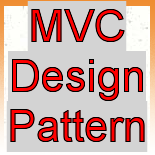MVC Design Pattern
In today's software applications
that need to deal with the presentation of a huge amount of data to the
end user, a software developer tries to make the application loosely coupled
via separating the data (model) from the user interface (view)
concerns.
To meet the same purpose MVC design patterns were introduced.
MVC design pattern allows to the user to make the application modules to be
loosely coupled thus making the code more flexible when the client requires
to add few more functionalities to the existing application.
MVC allows to introduce the changes
to the user interface without affecting data handling mechanism. Even it
allows the data to get reorganized without demanding for any change to the
user interface.
M in MVC stands for the MODEL
V in MVC stands for the VIEW
C in MVC stands for the CONTROLLER
MODEL
--Model section in an application allows to
use a persistent storage (such as a database) to store and manipulate the
data using a programming language.
--Model in MVC encapsulates the data access layer.
--Model implements all the complex business logics and makes the application
more modular and reusable.
VIEW
-- View Section in the MVC pattern renders the data
into a more interactive and presentable form.
-- Typically, View Section in the MVC pattern consists of the user interface
elements.
-- Even there may exist the multiple views for a single model to meet the
variety of purposes.
CONTROLLER
-- A Controller Section in the MVC pattern
manages all the requests coming through the user interfaces.
-- Only the controller is always responsible for accessing the model and
rendering various UIs according to the requirements.
-- Controller delegates the various user requests using the configuration
files in the XML formats.
Read more at :
www.roseindia.net/struts/mvc-architecture.shtml



